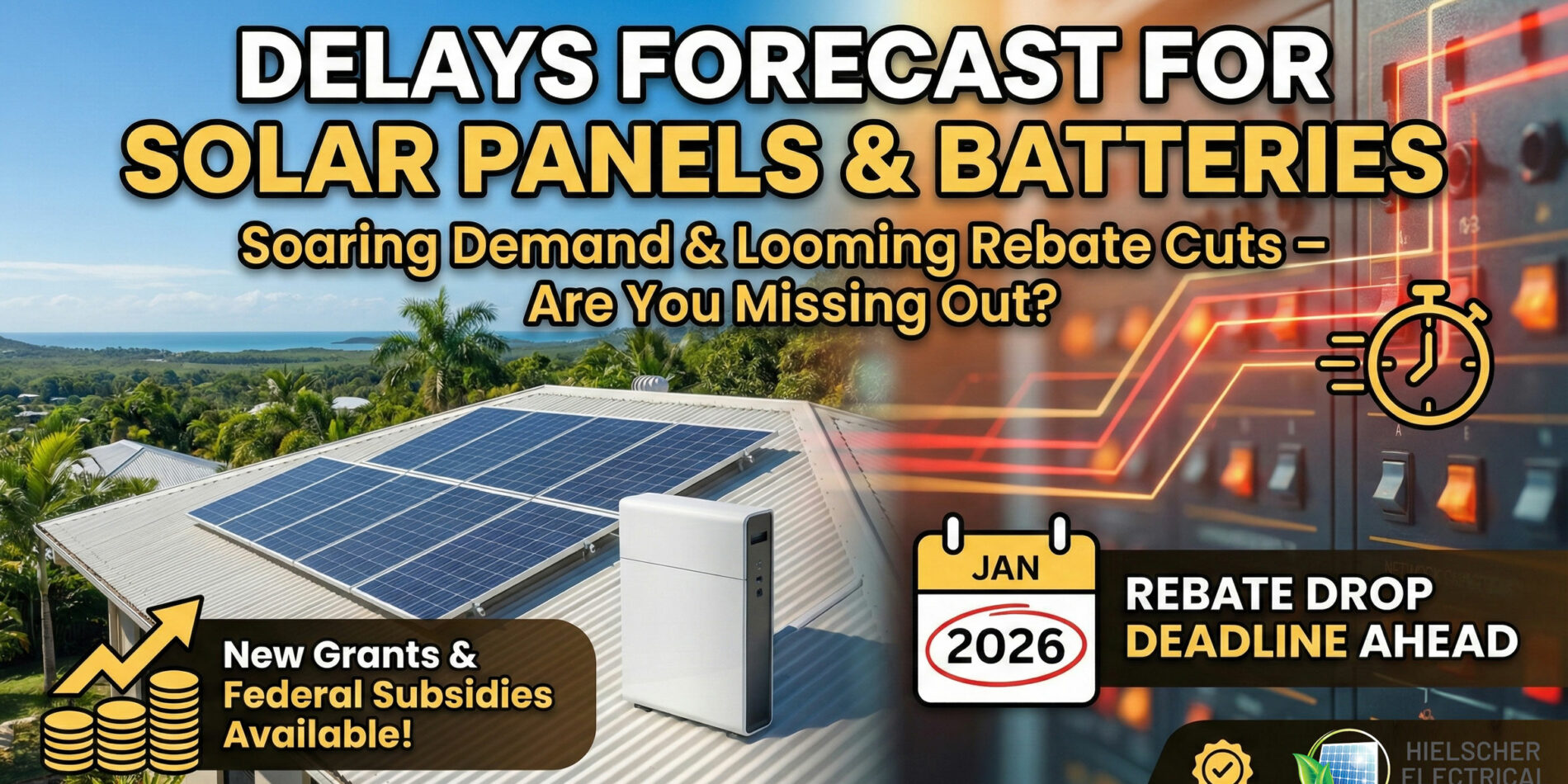
For households in Cairns and Far North Queensland, the solar transition is no longer an abstract climate goal. It’s playing out on rooftops, in Ergon bills and, increasingly, in waiting lists.
A cocktail of new state and federal rebates, stubbornly high power prices and a series of punishing hot seasons has pushed interest in rooftop solar and home batteries to record levels. Nationally, more than 4.2 million homes now have solar, with Queensland out in front on about 1.1 million systems. The industry estimates that a solar system paired with a battery can strip roughly $1,500 a year from a typical power bill.
In Cairns, where air conditioners work hard and network constraints are tightening, that promise is understandably attractive. But the rush is exposing a growing divide: those who can move quickly enough to claim the incentives and secure an installer, and those – renters, apartment dwellers and people in social housing – who are largely locked out.
It is also colliding with a hard deadline. From 1 January 2026, both the federal solar rebate (the “STC” scheme) and the current battery subsidy begin to step down again, reducing the level of support available for new systems. For households already thinking about solar or storage, that date is rapidly becoming a line in the sand.
A policy pivot, a battery boom – and a local grid under strain
Queensland’s broader energy story helps explain what is happening on Cairns rooftops.
Since late 2024, the state has moved from Labor’s highly ambitious Energy and Jobs Plan to the new Queensland Energy Roadmap 2025, introduced by the Liberal National Party government. The Roadmap repeals legislated renewable energy targets, extends the life of coal plants and elevates gas as “critical firming”, all under the banner of pragmatism and cost-of-living relief.
For Far North Queensland, the shift has two main consequences. At the large-scale end, big-ticket projects have been scaled back or slowed – most notably the CopperString 2032 transmission project, cut from a 500kV “super-highway” to a leaner 330kV line to save billions of dollars. At the household end, the Roadmap leans more heavily on consumer batteries and “behind-the-meter” solutions to manage a grid that is already heavily saturated with rooftop solar, particularly in the north.
Cairns is a case in point. Many suburbs now encounter export limits or dynamic export controls when they apply for a new solar connection. During the middle of the day, there is often so much local generation that the network can’t safely accept more. For new systems, that can mean little or no payment for surplus power sent back to the grid.
In that context, batteries are no longer a luxury add-on. They are increasingly the way households make use of power that would otherwise be “spilled” – charging during the day, then running appliances in the expensive evening peak. With a federal battery rebate of around 30% off eligible systems, and state policy actively encouraging storage, it is not surprising that demand has surged.

🌞 Save Money and Electricity 🌞
Get Solar Panels for Your Home!
🏠 Interested in solar panels? ☀️
Contact Hielscher Electrical and Solar now for a FREE onsite assessment and quote. Start saving today! 💰💡
In my work, I’ve come to see Cairns as a kind of proving ground for the distributed energy future – a place where thousands of small solar and battery systems are expected to carry more of the load on an already constrained grid. The challenge now is whether the industry, and the policies that shape it, can keep pace with that expectation.
The queues: why households are being told to wait
If you request quotes for solar or batteries in late 2025, it is common to be told that installation slots are weeks or even months away. In some parts of Queensland, installers report being booked out until at least the end of the year following the launch of the battery subsidy.
Initially, the bottleneck was hardware. Importers struggled to bring in enough batteries to meet the sudden spike in demand. That supply crunch has eased, but a deeper constraint remains: skilled labour.
In reality, the renewables push has landed on top of an already tight labour market. In my analysis, there is an acute shortage of electricians and electrical specialists in regional Queensland, especially in Far North Queensland, where mining and resources projects are competing for the same trades. On top of that, batteries and smart inverters simply take longer to design, install and commission than traditional grid-feed solar systems. The work is more complex, and the consequences of getting it wrong are much higher.
Governments have begun to respond. In Cairns, the new TAFE Clean Energy & Batteries Centre of Excellence is training electricians specifically in battery storage, EV charging and advanced grid connectivity – a joint $20 million state–federal investment. It should, over time, expand the pool of qualified local installers able to take on battery work.
But training takes years, not months. In the meantime, delays are largely unavoidable if you want a system designed, installed and commissioned by properly qualified tradespeople. In that sense, a wait-list is not necessarily a red flag; it can be a sign that a business is saying no to over-promising.
When rebates attract “shonky” operators
High demand and generous rebates do not only attract genuine installers.
Consumer advocates have been warning for some time that solar and battery subsidies can trigger waves of “too good to be true” offers. In submissions to the Australian Competition and Consumer Commission (ACCC), the Consumer Action Law Centre has called for an outright ban on unsolicited door-to-door solar sales, arguing that households are being pushed into complex, high-cost products they neither understand nor need.
Both industry insiders and consumer lawyers have seen the pattern before:
- Heavy pressure to “sign now” to avoid missing out on a rebate
- Systems sold on finance to people who cannot realistically afford the repayments
- Poor-quality hardware and rushed installs, with little interest in long-term performance or service
The ACCC has reminded solar and battery retailers that they remain bound by consumer law, even in a boom. But enforcement often trails harm.
For Cairns households, the practical question is how to tell reliable operators from opportunists. Long waiting lists can be frustrating, especially with rebate reductions looming, but they are not in themselves a sign of failure. By contrast, red flags include: reluctance to provide written, itemised quotes; a lack of Clean Energy Council–approved products; and an online footprint that looks polished on one review site but dire everywhere else.
Local firms such as Cairns-based Hielscher Electrical operate in this environment too. They are not immune to labour shortages or connection rules, but they do have a strong incentive to preserve reputation in a relatively small regional market. For consumers, looking for that longer-term local presence may offer more protection than chasing the lowest headline price.
The people who can’t get solar at all
The other side of the story is not the people who are waiting, but the people who are unable to join the queue in the first place.
Despite the scale of Queensland’s rooftop rollout, millions of Australians still cannot access solar. Renters, apartment residents and people in social housing typically do not control their own roofs. Even when a landlord is willing, split incentives get in the way: the owner pays for the system; the tenant receives the lower bills.
The Queensland government’s new grant for landlords – up to $3,500 towards rooftop solar – is an explicit attempt to chip away at that problem. Advocates argue it is a sensible use of public money: in a hot and tight rental market, landlords have had little financial incentive to invest in lower power bills for tenants, even as energy costs climb.
Elsewhere, more targeted schemes show what is possible. Victoria’s “solar for apartments” program, for example, has opened rebates to body corporates and smaller unit blocks, where a single rooftop system can be shared among multiple dwellings. In Queensland, some advocates are calling for similar initiatives, combined with community batteries located on street corners or in substations, so that people without their own roof can still benefit from shared local generation.
In Far North Queensland, the equity gap is layered over geography. Remote communities and islands are often dependent on diesel generation and fragile feeder lines. Projects such as the Mossman Gorge microgrid, where a community battery allows “islanding” during faults, are early attempts to boost resilience in these areas while keeping costs manageable. The Torres Strait Renewable Energy Transition Plan likewise recognises that simply bolting more panels onto tiny diesel grids can cause stability issues; smarter control systems are needed to orchestrate multiple small generators.

🌞 Save Money and Electricity 🌞
Get Solar Panels for Your Home!
🏠 Interested in solar panels? ☀️
Contact Hielscher Electrical and Solar now for a FREE onsite assessment and quote. Start saving today! 💰💡
For now, though, the basic pattern holds: the people who feel power price increases most acutely – renters on lower incomes, people in social housing, communities at the edge of the grid – are the ones least able to access the benefits of cheap rooftop solar and subsidised batteries.
A slower “SuperGrid”, a faster household transition
The broader Queensland policy environment is hardly designed to accelerate large-scale renewable projects in the north. The descoping of CopperString, new social impact requirements for wind farms in high-biodiversity areas like Wooroora and Gawara Baya, and the effective pause on ambitious hydrogen export schemes all suggest a more cautious stance from government and investors.
Those decisions matter for long-term jobs and industry strategy. But they do not stop the household-level transition. If anything, they may push more of the decarbonisation burden onto distributed energy resources: rooftop solar, batteries, smart appliances and demand management in homes and small businesses.
From my perspective, this is exactly what’s playing out in Cairns. With large industrial loads delayed – the Cairns Marine Precinct Common User Facility, for example, still constrained by limited firm power supply at the port – most of the visible progress is happening on domestic roofs and in small commercial sheds. In effect, the region is being asked to solve a state-level policy problem at the household level.
That makes consumer protections, fair access to incentives and competent local workforce planning all the more important.
The 1 January 2026 deadline – and how to think about it
Against this backdrop, the approaching 1 January 2026 rebate reduction takes on added significance.
Two things happen on that date:
- The federal solar rebate (based on “small-scale technology certificates”) steps down again as part of its long-planned phase-out.
- The current battery subsidy is scheduled to taper, reducing the proportion of system cost covered by public money.
For policymakers, this is a predictable budgetary and scheme-design issue. For households, it is much more tangible: wait too long, and the same system will simply cost more.
It is tempting, especially in marketing material, to turn that into a crude countdown clock. But the reality is more nuanced. Experts are clear that no one should be rushed into unaffordable debt or pressured into signing contracts they do not understand, simply to meet a rebate deadline. At the same time, it is reasonable to say that if a household has already decided it will install solar or a battery “at some point”, starting the process sooner rather than later will generally leave them better off.
In practical terms, that means:
- Allowing for lead times – for site assessments, grid applications, meter changes and the installer’s schedule – rather than assuming a system can be ordered in November and installed before Christmas.
- Using the time before 2026 to gather multiple quotes, read contracts carefully and assess the real bill impacts.
- Considering system design in light of Cairns-specific constraints: export limits, evening air-conditioning loads, storm resilience and any plans to add an EV later.
Local installers such as Hielscher Electrical are already advising customers to think in those terms: not a rush, but a deliberate sequence of planning, design and installation that recognises both the rebate timetable and the realities of FNQ’s grid.
What a fair transition would look like
The current surge in demand for solar panels and batteries in Cairns and Far North Queensland is, on one level, a success story. Households are taking control where they can, investing their own money in technology that lowers bills and reduces emissions. Policy settings – particularly the battery rebate – are nudging them in that direction, and local training initiatives suggest governments recognise the need for a bigger, better-skilled workforce.
Yet the delays and access gaps tell a more complicated story. A transition that leans heavily on private rooftop investment will, almost by definition, move fastest for those who own property, have savings or access to finance, and live in locations where the grid rules still permit exports. Those outside that circle risk being left on the wrong side of a new divide: still exposed to high tariffs and outages, but without the means to generate their own power.
For Cairns, the coming year is likely to cement that pattern. Unless schemes are expanded to renters and apartment dwellers, and unless community-scale projects such as batteries and microgrids are rolled out more widely, the benefits of the solar boom will continue to be unevenly distributed.
Against that backdrop, the 1 January 2026 rebate reduction is best seen not as a hard stop, but as a milestone. The energy transition will continue beyond it. But for those who can participate now – and who can do so safely, with proper advice and realistic expectations – there is a rational case for acting before the clock ticks over, rather than after.
Get in contact with Hielscher Electrical now for a free quote and expert advice.





